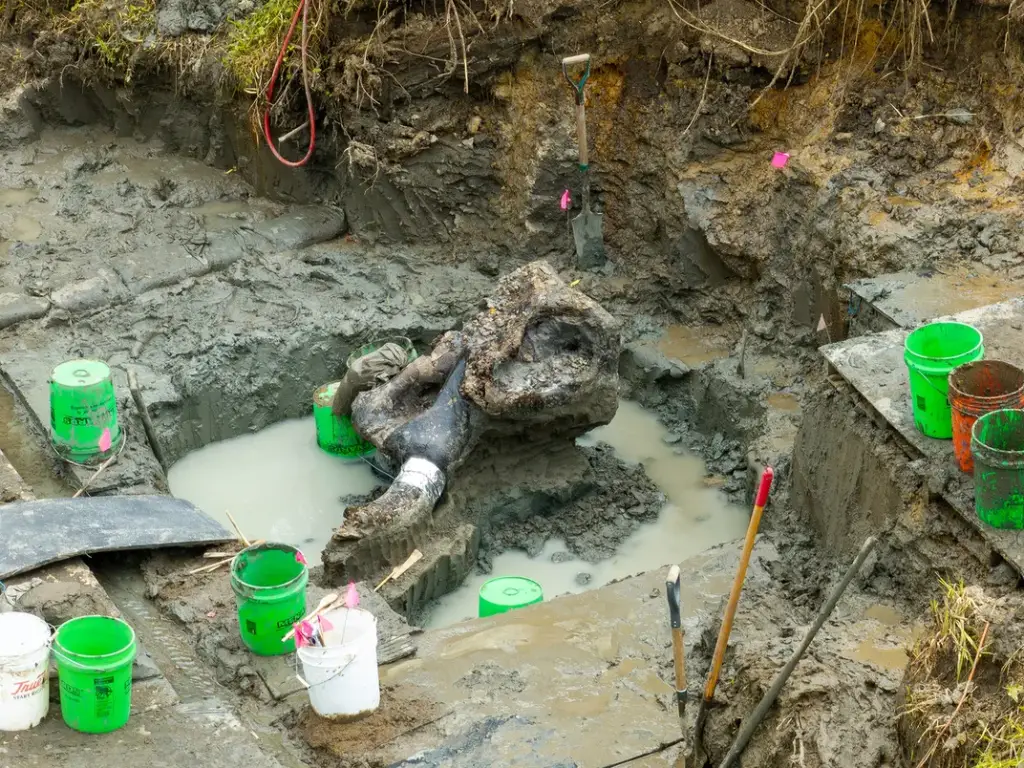Archaeologists Unearth 13,600-Year-Old Mastodon Skull in Iowa, Possibly Linked to Early Human Hunters
TL;DR
Archaeologists have discovered a 13,600-year-old mastodon skull in southern Iowa, shedding light on Ice Age wildlife and human interaction. The skull, found in Wayne County, could have belonged to a mastodon that roamed when Indigenous people first arrived in the area. Along with the skull, archaeologists unearthed stone tools, marking evidence of early humans in the region. Researchers hope to find signs of human interaction with the mastodon, including cut marks or hunting tools, which may reveal more about the relationship between early humans and megafauna.
Archaeologists have uncovered the well-preserved skull of a mastodon that lived 13,600 years ago in southern Iowa.

It’s possible this creature encountered Indigenous people, who began arriving in the region around that time.
“The last ice age probably still had northern Iowa covered in ice,” says John Doershuk, Iowa’s state archaeologist, to Iowa Public Radio’s Zachary Oren Smith. “But the southern region was free of ice and starting to grow vegetation, attracting animals like mastodons, and making it a favorable spot for human hunters too.”
Archaeologists spent nearly two weeks excavating the skull in Wayne County, a rural area about 80 miles south of Des Moines. The State Archaeologist’s Office first learned of the discovery in fall 2022 after a man shared a photo of himself on social media.
“It was a picture of this young guy,” Doershuk tells Radio Iowa’s Dar Danielson. “Huge smile, holding a massive 45-inch bone like something out of Fred Flintstone.”
The bone was identified as a mastodon femur, found in a creek bed on private land, according to the University of Iowa. When archaeologists visited the site in the fall of 2023, they also found a broken tusk sticking out of the ground. Suspecting it was connected to a skull, they quickly planned an excavation.
Besides the skull, they found stone tools at the site. Though these tools date back a few thousand years after the mastodon’s death, they mark the first evidence of humans in the area.
The team hopes to find signs of human interaction with the mastodon, such as knives or projectiles used for hunting or butchering. They also aim to examine the skull to look for possible cut marks from humans.
The skull still has a two-foot section of tusk attached, which researchers hope will shed light on the mastodon’s life.
“Apparently, there are methods now to determine how many calves a female mastodon had by studying the chemical changes in the tusks that occur during pregnancy and birth,” Doershuk explains to Iowa Public Radio.
Next, archaeologists and paleontologists will study and preserve the fossils. Eventually, the specimen will be part of a new exhibit at the Prairie Trails Museum of Wayne County.

Mastodons were large, shaggy relatives of woolly mammoths and modern elephants. They roamed the Earth beginning in the Miocene epoch (from 23 million to 2.6 million years ago) and went extinct around 10,500 years ago.
Standing as tall as 9.8 feet at the shoulder, they had two upward-curving tusks and used their pointed teeth to grind up twigs, leaves, and other vegetation. While they were slightly smaller than woolly mammoths, their size was comparable to today’s elephants.
Scientists continue to debate the causes of mastodon and mammoth extinction, with climate change and human hunting likely playing a role.
Mastodon and mammoth fossils are relatively common in North America. In October 2022, a couple in Alaska discovered a mammoth femur on a beach after a typhoon, and in June 2023, a woman found a mastodon molar on a California beach. Just recently, a man found a 7-foot-long Columbian mammoth tusk in a Mississippi creek.Researchers continue to use these fossils to make scientific breakthroughs. Earlier this year, scientists reconstructed the 3D structure of a woolly mammoth’s DNA using freeze-dried skin that was 52,000 years old. Fossilized tusks have also been used to show that woolly mammoths experienced musth, a period of heightened reproductive hormones.




